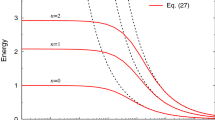Abstract
Following Salpeter, the Bethe-Salpeter equation for the bound system of two oppositely charged particles is reduced to a Schrödinger equation for each of the following cases: (a) both particles are spin 1/2 particles, (b) one particle is a spinor while the other is spinless, and (c) both particles are spinless. It is shown that ife is the magnitude of charge carried by each of the particles whose masses are set equal to the electron and proton masses then, strictly speaking, only in case (a) do we obtain the familiar Schrödinger equation for the hydrogen atom. The latter equation is recovered in the other two cases only if relativistic remnants—terms of the order of 10−5 and smaller—are neglected in comparison with unity. Attention is drawn to a situation where such remnants may not be negligibly small, viz. the problem of confinement of quarks.
Similar content being viewed by others
References
Alabiso C and Schierholz G 1977Nucl. Phys. B126 461
Biswas S N, Datta K and Goyal A 1982Phys. Rev. D25 2199
Bjorken J D and Drell S D 1965Relativistic quantum fields (New York: McGraw Hill)
Copson E T 1970An introduction to the theory of functions of a complex variable (London: Oxford Press)
Henley J R 1979Phys. Rev. D20 2532
Henley J R 1980Phys. Rev. D22 419
Mainland G B 1986J. Math. Phys. 27 1344
Malik G P, Malik U and Varma V S 1991Astrophys. J. (submitted)
Malik G P, Pande L K and Varma V S 1989Pramana — J. Phys. 32 L89
Malik G P, Pande L K and Varma V S 1991Astrophys. J. 379 788
Quigg C and Rosner J L 1976Phys. Rep. 56 167
Salpeter E E 1952Phys. Rev. 87 32
Author information
Authors and Affiliations
Rights and permissions
About this article
Cite this article
Malik, G.P., Singh, S. & Varma, V.S. Relativistic remnants in the reduction of the Bethe-Salpeter equation to the Schrödinger equation. Pramana - J Phys 38, 319–327 (1992). https://doi.org/10.1007/BF02875377
Received:
Revised:
Issue Date:
DOI: https://doi.org/10.1007/BF02875377




